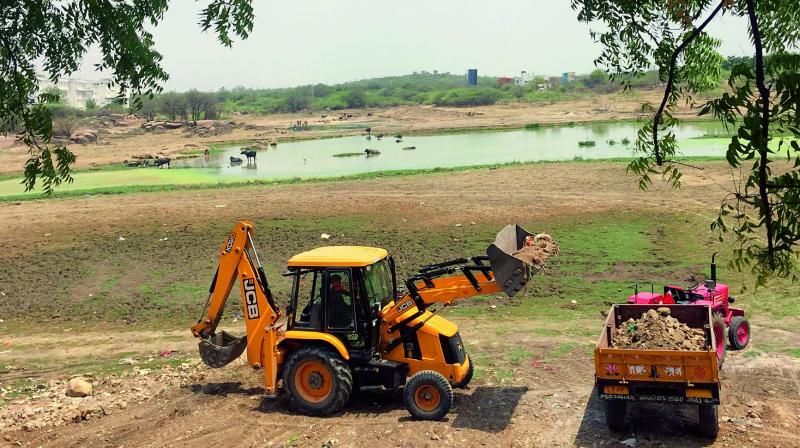Putting life back into Peerancheruvu Lake

Nine years ago, Anuradha Raju drove by a glistening Peerancheruvu Lake while searching for a suitable home for her family of four to shift from Mumbai. As she drove along a snaking road, she remembers being awed by the view — a blue-green still lake, ensconced by trees and hills. Shortly after, they made the decision to move into the nearby PBEL City complex in Peerancheruvu.
The very same sight today however, is hard to swallow — the lake lies bare, nearly drained of all water, with its sun-scorched bed an unsightly dump of litter and muck. The freshwater lake, which once had a healthy population of birds, including painted storks, herons, migrant waders, ducks, egrets, pond herons and kingfishers, now lies bereft of the same, thanks to garbage, pollution and water scarcity. Anuradha, who has since moved to Banjara Hills, is today among a group of volunteers who are leading an impassioned drive to save the lake. “The attachment to the lake is just too strong to stay away,” she explains.
Harsh realities and hope
Last year, a report by government think-tank Niti Aayog warned that Delhi, Bengaluru and Hyderabad will be among 21 Indian cities to run out of groundwater by 2020. The results are already being felt in the neighbourhood where dozens of borewells around the lake have dried up. Fortunately for locals, last year, the Hyderabad Metropolitan Development Authority (HMDA) listed the lake among 20 that will be beautified. On the anvil is work to improve the holding capacity of lakes, divert sewage and strengthen the bunds at an estimated cost of Rs 1.1 crore. The second phase will focus on beautification such as planting trees, building walkways and installing benches, the cost of which remains unclear. The Peerancheruvu Lake Revival Volunteer Group is however, leaving nothing to chance. Such is their dedication that even under the scorching midday sun, a group of four walked for hours one day inspecting the lake works with the deputy executive engineer of HMDA and expressing their concerns. One such concern is a drainage pipe that is being laid at the lake. They fear it could leak and contaminate the water, therefore turning all the effort into waste — quite literally. Member Dhiraj Kaveri says, “We raised concerns about sewage and storm water which will be diverted from the main inflow on Chevella road into the lake but were told that it is the only available solution within their scope of work.” The group has drawn up a list of their own recommendations and started a signature campaign as well. Supported by the neighbourhood children, the campaign has already collected more than 500 signatures, and will be handed over to the authority soon.
Additional concerns
Speaking of other apprehensions, member Prameela Gollamandala says, “Concerns were raised around untreated sewage pipes from surrounding areas being let into the lake. We informed the authorities.” She explains that water inlets from the nearby Snehita Hills are blocked, forcing the water to find other outlets which is why the lake is drying up. 46-year-old Gollamandala, who has a Masters of Engineering in Water Resources had worked as technical coordinator with NGO World Vision in Bhuj, creating several dams. The contrast between the two situations has been bitter. “Peerancheruvu is a freshwater lake which had largely remained unpolluted as there are no large scale industries around but in no time, all the water disappeared,” she says. Other concerns include illegal encroachments and garbage dumping. “We want to ensure that the lake is preserved for its ecosystem that humans are dependent on too. Birds and animals can and will die without it. The urgent need is to preserve the full extent of this 35-acre lake, the buffer zone and the natural inflow channels,” says Anuradha Raju, further adding, “While the government’s beautification plans may be to build cycle and walking paths, they should not be the primary concerns. We have taken the initiative because we care for our environment and our precious natural resources.”

